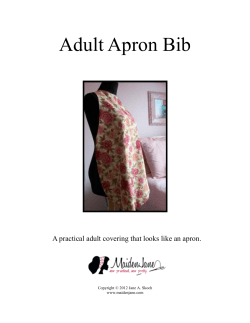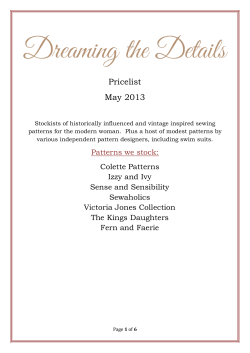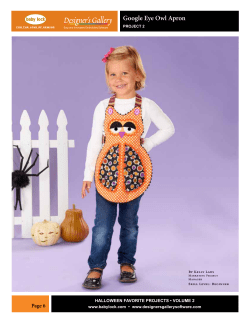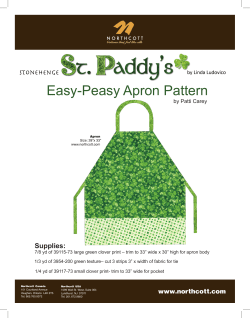
File - Port Library
A Quick History of Aprons As long as there has been clothing, dirty work, and the need to keep clean aprons have existed. However, the earliest recorded instance of aprons can be found in medieval paintings starting in the 1300s. (1) 2 - "Lady with a Yellow Flower" by Cronenberg c1567 Until the 1500s, nobility didn’t wear aprons, but changing fashions started including fancy aprons with some ladies’ gowns. (2) Fashions continued to change and by the late 1600s aprons had become very ornate with embroidery on both the body of the apron and on the ties. However, the overall style remained strictly below the waist. (3) 4 - Detail from "The First Thanksgiving 1621" by Ferris 1 - from an English calendar, c1325 When aprons traveled over to the new world, it was first on the Pilgrim women, who kept things very simple, (4) while Quaker women were allowed colorful silk aprons. Meanwhile, over in England after Charles II took the throne and Louis the XIV ruled, aprons became competitively fashionable, one even reported to cost the equivalent of over $32,000! 3 - a European apron of linen with gold and silk embroidery c1600s By the 1700s “pinner” aprons became popular. (5) The style was tied at the waist, while the upper part was pinned near the shoulders. The pinner style apron and half aprons continued to be popular into the mid-1800s, when westward expansion and the civil war introduced shoulder straps for utility. (6) 6 - House staff with mouser. c1865 By the Victorian era women were using aprons for both utility and fashion, and women’s magazines and pattern companies began offering patterns for such garments. (7) 5 - Pinner apron. c1700s The 1920s and into the mid-1930s flour companies, in an effort to make their packaging more economical introduced the idea of feed sack or flour sack aprons and other garments. (8) Most of these aprons were used, and used up, although some vintage styles can be found. By the 1940s aprons were becoming a fashion statement in their own right, pictured by pattern companies over more plain looking dresses. (9) 8 - An ad touts the possibilities with flour sack cloth. c1930s 7 - Victorian era aprons. c1900s 10 - Simplicity Retro Apron Pattern #2592 The trend of fashionable aprons continued through the 1960s. By the 1980s the working woman spent less time in the kitchen and new apron fashions weren’t present in stores or in pattern company catalogs as much. Then, in the mid 2000s vintage styles became popular again, and many pattern companies began re-releasing styles, including aprons. (10) Online bloggers and crafters have made home-making attractive again, and a new generation had discovered the necessity and utility of aprons. 9 - Illustration from an apron pattern c1940s Apron Styles: Pinafore: Originally a "bib" style apron that covered the chest and fastened with pins, hence it's name. Commonly associated with a ruffled apron in the 1900s that little girls wore. It was also popular in the 1940s. Pinny: British slang for pinafore or apron. Hostess Apron: A 1950s term for a half apron. Usually of a daintier fabric, i. e. organdy, lace, satin, silk, cotton lawn. Also a term for an apron that was make for "show" and not for actually work. Also called a Cocktail Apron or Party Apron. Bib: The top portion of an apron that covers the chest, usually a simple square. Half Apron: An apron that ties around the waist with no bib. Usually gathered or pleated into a waistband. Full Apron: Used to describe an apron that covers the whole front, not a half apron. Princess Apron: A full apron with bib and skirt cut in one with no waist seam. Very popular in the 1920s and 1930s. Smock: More like a dress, than an apron. Can have sleeves. Popular in the 1930s for painting and gardening. Cobbler Apron: An apron that covers the front and the back, usually straight with ties or buttons at the sides. Popular in the late 1950s and 1960s. Chef’s Apron: A traditional apron made in one piece with a straight "skirt" and bib. Goes over the head and ties in back with ties. Also called a Butcher apron. Sources: Feedsack Secrets: Fashion from Hard Times by Gloria Nixon, published by Kansas City Star Books, c2010 http://r.ebay.com/GCmJex http://www.acmeaprons.com/history-of-aprons.html http://www.larsdatter.com/aprons.htm https://sites.google.com/site/apronhistory/
© Copyright 2025









